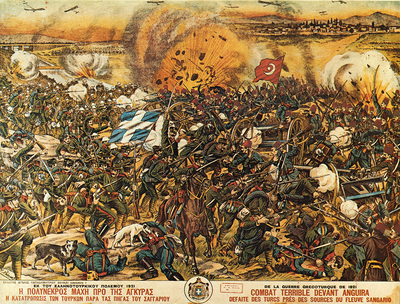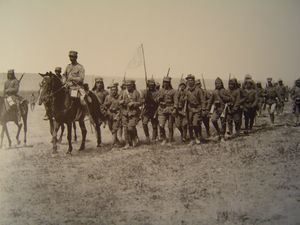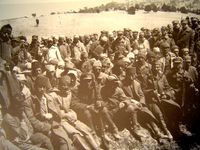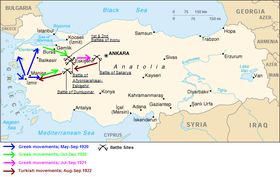معركة سكاريا
| معركة سكاريا | |||||||
|---|---|---|---|---|---|---|---|
| جزء من the Greco-Turkish War and the Turkish War of Independence | |||||||
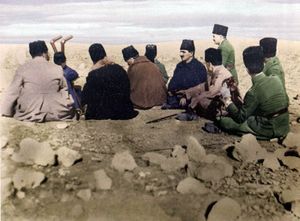 At Duatepe observation hill (في Polatlı): Fevzi Çakmak, Kâzım Özalp, مصطفى كمال أتاتورك، عصمت إينونو و خير الله فيشق | |||||||
| |||||||
| المتحاربون | |||||||
|
|
| ||||||
| القادة والزعماء | |||||||
|
|
| ||||||
| القوى | |||||||
|
96,326 soldiers 5,401 officers 54,572 rifles 825 machine guns 196 cannons 1,309 swords 2 aircraft [5] |
120,000 soldiers 3,780 officers 57,000 rifles 2,768 machine guns 386 cannons 1,350 swords 600 3-ton trucks 240 1-ton trucks 18 airplanes[5] | ||||||
| الضحايا والخسائر | |||||||
|
3,700 dead 18,480 wounded 108 captives 5,639 deserters 8,089 missing Total: 38,029[6][Note 1] |
From August 23 to September 16:[8] 4,000 dead 19,000 wounded 354 missing Total: 22,900 | ||||||
معركة سكاريا (تركية: Sakarya Meydan Muharebesi)، وتُعرف أيضاً بإسم معركة السنگاريو (باليونانية: Μάχη του Σαγγάριου)، كانت اشتباكاً هاماً في الحرب التركية اليونانية (1919–1922)، الجبهة الغربية من حرب الاستقلال التركية.
استمرت المعركة لمدة 21 يوماً من 23 أغسطس حتى 13 سبتمبر 1921، بالقرب من ضفاف نهر سكاريا in the immediate vicinity of Polatlı, which is today a district of the محافظة أنقرة.[9] The battle line stretched over 62 miles (100 km).[10]
It is also known as the "Officers’ Battle"[11] (Subaylar Savaşı) in Turkey because of the unusually high casualty rate (70-80%) among the officers.[12]
The Battle of Sakarya is considered as the turning point of the Turkish War of Independence.[13][14][15][16][17][18][19] A Turkish observer, writer and literary critic İsmail Habip Sevük, later described the importance of the battle with the words, "the retreat that started in Vienna on 13 September 1683 stopped 238 years later".[20]
المعركة
Aftermath
The retreat from Sakarya marked the end of the Greek hopes of imposing settlement on Turkey by force of arms. In May 1922 General Papoulas and his complete staff resigned and was replaced by General Georgios Hatzianestis, who proved much more inept than his predecessor.[21]
On the other hand, Mustafa Kemal returned in triumph to Ankara where the Grand National Assembly awarded him the rank of Field Marshal of the Army, as well as the title of Gazi rendering honours as the saviour of the Turkish nation.[22]
According to the speech that was delivered years later before the same National Assembly at the Second General Conference of the Republican People's Party which took part from October 15 to October 20, 1927; Kemal said to have ordered that " ... not an inch of the country should be abandoned until it was drenched with the blood of the citizens...," upon realizing that the Turkish army was losing ground rapidly, with virtually no natural defenses left between the battle line and Ankara.[23][24]
Lord Curzon argued that the military situation became a stalemate with time tending in favour of the Turks. The Turkish position within the British views was improving. In his opinion, the Turkish Nationalists were at that point more ready to treat.[25]
After this, the Ankara government signed the Treaty of Kars with the Russians, and the most important Treaty of Ankara with the French, thus reducing the enemy's front notably in the Cilician theatre and concentrating against the Greeks on the West.[26]
For the Turkish troops it was the turning point of the war, which would develop in a series of victorious clashes against the Greeks, driving out the invaders from the whole Asia Minor in the Turkish War of Independence.[27] The Greeks could do nothing but retreat.
As by August 26. 1922 Turkish offensive started with Battle of Dumlupınar. Kemal dispatched his army on a drive to the coast of the Aegean Sea pursuing the shattered Greek army, which would culminate in the direct assault of Smyrna between September 9 and 11th 1922.
The war would be over and sealed with the defeat of the Greeks, formalized by the Treaty of Lausanne on July 24. 1923.
See also
Gallery
Evzones attack
الهامش
- ^ Michael Llewellyn Smith "Ionian Vision" Hurst & Company London 1973 ISBN 1-85065-413-1, pg.227–234
- ^ Christopher Chant "Warfare of the 20th. Century – Armed Conflicts Outside the Two World Wars" Chartwell Books Inc. New Jersey 1988. ISBN 1-55521-233-6, pg.21–23
- ^ Michael Llewellyn Smith "Ionian Vision" Hurst & Company London 1973 ISBN 1-85065-413-1, pg.227–232
- ^ Michael Llewellyn Smith "Ionian Vision" Hurst & Company London 1973 ISBN 1-85065-413-1, pg.234
- ^ أ ب Battle of Sakarya Archived يونيو 27, 2009 at the Wayback Machine, Turkish General Staff, retrieved: 12 Ağustos 2009.
- ^ Zeki Sarıhan: Kurtuluş Savaşı günlüğü: açıklamalı kronoloji. Sakarya savaşı'ndan Lozan'ın açılışına (23 Ağustos 1921-20 Kasım 1922) (engl.:Diary of the independence war: commented chronology. From battle of Sakarya to the opening of Lausanne (23 August 1921-20 November 1922)), Türk Tarih Kurumu yayınları (publishing house), 1996, ISBN 975-16-0517-2, page 62.
- ^ Celâl Erikan: 100 [i.e. Yüz] soruda Kurtuluş Savaşımızın tarihi, Edition I, Gerçek Yayınevi, 1971, İstanbul, page 166. (لغة تركية)
- ^ Σαγγάριος 1921, Η επική μάχη που σφράγησε την τύχη του Μικρασιατικού Ελληνισμού, Εκδόσεις Περισκόπιο, Ιούλιος 2008, ISBN 978-960-6740-45-9, page 32
- ^ Campbell, Verity; Carillet, Jean-Bernard; Elridge, Dan; Gordon, Frances Linzee (2007). Turkey. Lonely Planet. ISBN 1-74104-556-8.
- ^ Edmund Schopen: Die neue Türkei, Wilhelm Goldmann Verlag, 1938, page 95. (بالألمانية)
- ^ Sean McMeekin, The Berlin-Baghdad Express: The Ottoman Empire and Germany's Bid for World Power , Harvard University Press, 2010, ISBN 978-0-674-05739-5, p. 302.
- ^ Osman Faruk Loğoğlu, İsmet İnönü and the Making of Modern Turkey, İnönü Vakfı, 1997, ISBN 978-975-7951-01-8, p. 56.
- ^ Revue internationale d'histoire militaire Volumes 46-48, International Committee of Historical Sciences. Commission of comparative military history, 1980, page 222
- ^ International review of military history (Volume 50), International Committee of Historical Sciences. Commission d'histoire militaire comparée, 1981, page 25.
- ^ Dominic Whiting, Turkey Handbook, Footprint Travel Guides, 2000, ISBN 1-900949-85-7, page 445.
- ^ Young Turk, Moris Farhi, Arcade Publishing, 2005, ISBN 978-1-55970-764-0, page 153.
- ^ Kevin Fewster, Vecihi Başarin, Hatice Hürmüz Başarin, A Turkish view of Gallipoli: Çanakkale, Hodja, 1985, ISBN 0-949575-38-0, page 118.
- ^ William M. Hale Turkish foreign policy, 1774-2000, Routledge, 2000, ISBN 0-7146-5071-4, page 52.
- ^ Michael Dumper, Bruce E. Stanley: Cities of the Middle East and North Africa: a historical encyclopedia, ABC-CLIO, 2007, ISBN 1-57607-919-8, page 38.
- ^ Kate Fleet, Suraiya Faroqhi, Reşat Kasaba: The Cambridge History of Turkey (Volume 4), Cambridge University Press, 2008, ISBN 0-521-62096-1, page 138.
- ^ خطأ استشهاد: وسم
<ref>غير صحيح؛ لا نص تم توفيره للمراجع المسماةChristopher Chant, pg.23 - ^ Shaw, Stanford Jay (1976), "History of the Ottoman Empire and Modern Turkey", Cambridge University Press, ISBN 978-0-521-21280-9, pg.357
- ^ Turkish: Dedim ki: «Hatt-ı müdafaa yoktur, Saht-ı müdafaa vardır. O satıh, bütün vatandır. Vatanın, her karış toprağı, vatandaşın kaniyle ıslanmadıkça, terkonuamaz. Onun için küçük, büyük her cüz-i tam, bulunduğu mevziden atılabilir. Fakat küçük, büyük her cüz-i tam, ilk durabildiği noktada, tekrar düşmana karşı cephe teşkil edip muharebeye devam eder. Yanındaki cüz-, tamın çekilmeğe mecbur olduğunu gören cüz-i tamlar, ona tâbi olamaz. Bulunduğu mevzide nihayete kadar sebat ve mukavemet mecburdur.», Gazi M. Kemal, Nutuk-Söylev, Cilt II: 1920-1927, Türk Tarih Kurumu Basımevi, ISBN 975-16-0195-9, pp. 826-827.
- ^ English: I said that there was no line of defence but a plain of defence, and that this plain was the whole of the country. Not an inch of the country should be abandoned until it was drenched with the blood of the citizens..., A speech Delivered by Mustafa Kemal Atatürk, 1927, Ministry of Education Print. Plant, 1963, p. 521.
- ^ Michael Llewellyn Smith, pg.240
- ^ Michael Llewellyn Smith, pg.241
- ^ Shaw, Stanford Jay; , pg.362
ملاحظات
- ^ Although Turkish casualties state 5,639 deserters and 8,089 missing, these two casualty figures belong to the period between the Battle of Kütahya–Eskişehir and the Battle of Sakarya.[7]
ببليوگرافيا
- Smith, Michael Llewellyn (1973), Ionian Vision – Greece in Asia Minor 1919–1922, Hurst & Company London, ISBN 1-85065-413-1
- Chant, Christopher (1988), Warfare of the 20th. Century – Armed Conflicts Outside the Two World Wars, Chartwell Books Inc. New Jersey, ISBN 1-85065-413-1
انظر أيضاً
| المفاهيم | تقسيم الدولة العثمانية - تأسيس الحركة - الثوريون الأتراك - الحركة القومية التركية | ||||
|---|---|---|---|---|---|
| القضايا | أزمة چناق - تبادل السكان - الأشخاص غير المرغوب فيهم - منفيو مالطة - مجتمعات الثغور - لجنة كنگ-كرين - حركة الخلافة | ||||
| الحملات | البريطانيون (الحلفاء): اسطنبول | ||||
| الثورات: القوة الانضباطية - تمرد أحمد أزناڤور - تمرد كوچكيري | |||||
| الفرنسية: ماراش - عينتاب - اورفا | |||||
| اليونانية : سميرنا (إزمير) - أيدين - إينونو الأولى - إينونو الثانية - سكاريا - دملوپينار | |||||
| الأرمنية : اوتلو – ساريقامش – قارص – ألكسندروپول | |||||
| الاتفاقيات | خط زمني | ||||
|
الحلفاء: مؤتمر لندن - الدولة العثمانية: مؤتمر باريس للسلام, 1919 - مؤتمر سان ريمو - (البرلمان العثماني:) ميثاق ملي - معاهدة سيڤر | |||||
| الثوريون الأتراك: معاهدة ألكسندروپول - معاهدة موسكو (1921) - مؤتمر لندن - معاهدة سلام قيليقيا - معاهدة أنقرة (1921) - معاهدة قارص - مؤتمر لندن - هدنة مدانية - مؤتمر لوزان - معاهدة لوزان | |||||
- Pages using Lang-xx templates
- Articles containing Greek-language text
- Turkey articles missing geocoordinate data
- All articles needing coordinates
- نزاعات 1921
- Battles of the Greco-Turkish War (1919–22)
- مصطفى كمال أتاتورك
- ولاية أنقرة
- 1921 في الدولة العثمانية
- تاريخ محافظة سكاريا
- أحداث أغسطس 1921
- أحداث سبتمبر 1921
